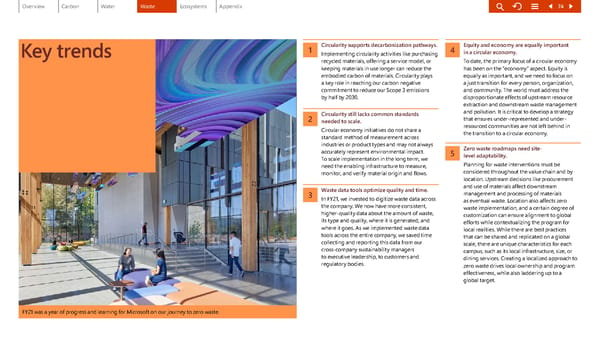Key trends 1 Circularity supports decarbonization pathways. Implementing circularity activities like purchasing recycled materials, offering a service model, or keeping materials in use longer can reduce the embodied carbon of materials. Circularity plays a key role in reaching our carbon negative commitment to reduce our Scope 3 emissions by half by 2030. 2 Circularity still lacks common standards needed to scale. Circular economy initiatives do not share a standard method of measurement across industries or product types and may not always accurately represent environmental impact. To scale implementation in the long term, we need the enabling infrastructure to measure, monitor, and verify material origin and flows. 3 Waste data tools optimize quality and time. In FY21, we invested to digitize waste data across the company. We now have more consistent, higher-quality data about the amount of waste, its type and quality, where it is generated, and where it goes. As we implemented waste data tools across the entire company, we saved time collecting and reporting this data from our cross-company sustainability managers to executive leadership, to customers and regulatory bodies. 4 Equity and economy are equally important in a circular economy. To date, the primary focus of a circular economy has been on the “economy” aspect. Equity is equally as important, and we need to focus on a just transition for every person, organization, and community. The world must address the disproportionate effects of upstream resource extraction and downstream waste management and pollution. It is critical to develop a strategy that ensures under-represented and under- resourced communities are not left behind in the transition to a circular economy. 5 Zero waste roadmaps need site- level adaptability. Planning for waste interventions must be considered throughout the value chain and by location. Upstream decisions like procurement and use of materials affect downstream management and processing of materials as eventual waste. Location also affects zero waste implementation, and a certain degree of customization can ensure alignment to global efforts while contextualizing the program for local realities. While there are best practices that can be shared and replicated on a global scale, there are unique characteristics for each campus, such as its local infrastructure, size, or dining services. Creating a localized approach to zero waste drives local ownership and program effectiveness, while also laddering up to a global target. FY21 was a year of progress and learning for Microsoft on our journey to zero waste. 74
 Environmental Sustainability Report | Microsoft Page 73 Page 75
Environmental Sustainability Report | Microsoft Page 73 Page 75